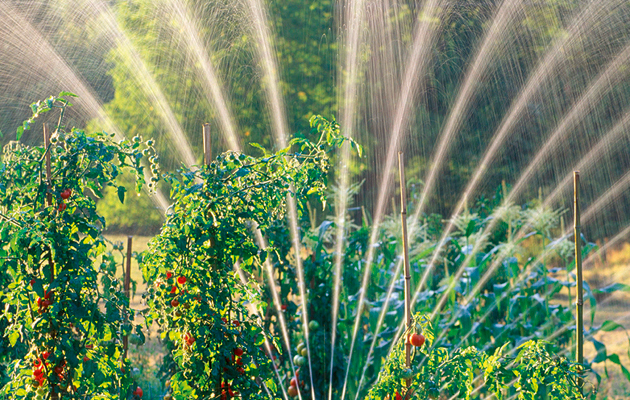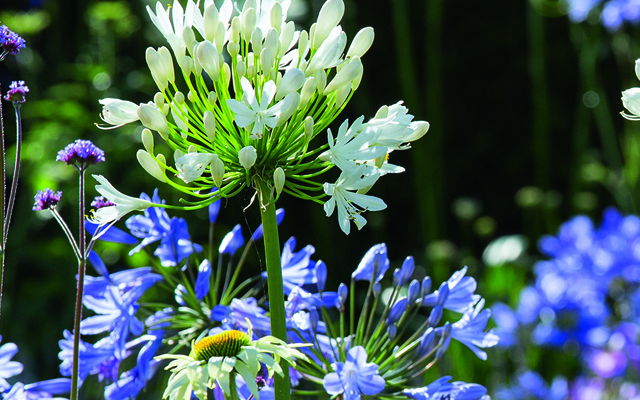The benefits of an irrigation system
Alan Titchmarsh wants water, water everywhere.


If memory serves me correctly, Vita Sackville-West would desert her famous English garden in August, remarking that it was, in effect, burnt up and that there was little else to see until the joys of autumn evidenced themselves. After a dry June and July, it’s likely that many of us will feel the same this year.
Lawns are parched and unwatered, herbaceous borders will be showing signs of crisping up, the plants themselves checked in their growth and the bottom leaves turning to parchment on many. Only trees and shrubs that can send their roots deeper into the soil in search of moisture reserves are likely to be unaffected and even these begin to struggle when drought is prolonged.
While making a new garden on the Isle of Wight, I have endeavoured to take account of this, not least because we’re not full-time residents. Our visits are frequent, but, after an absence of even a week in really scorching weather, new plants that haven’t yet established their root systems in the soil are liable to wither and perish, leaving gaps in beds and borders and an aching heart on the part of me, the gardener.
To this end, I have pushed the boat out and installed an irrigation system linked to small computers that are attached to garden taps. Generally, computer technology leaves me cold, but needs must and the smart little boxes with screens that sit side by side below two outlets affixed to each tap leave me feeling wonderfully reassured that my new maritime treasures will not turn to crisps in my absence.
They come on in rotation, watering one bed or border at a time to make sure that water pressure is maintained—an unlikely event if all the outlets were to be running concurrently.
I thought carefully about the kind of irrigation system I wanted. Many years ago, I visited a friend’s garden, where, in the early hours of the morning, jets would pop up all over the garden, drenching it in a prolonged shower as if from heaven, scheduled to end before the household rose for breakfast. The timing was impeccable (if we all had to choose when rain fell, it would be after retiring and before rising), but the water itself lay on foliage and flower, often bending them towards the ground and frequently evaporating before it had a chance to soak into the earth.
My own choice is for seeper hose, soaker hose or leaky pipe, depending on what you—or the manufacturer—wish to call it. These lengths of black, rough-textured pipe are laid on the surface of the soil in zig-zag fashion among the plants and pinned to the ground with special plastic pegs. A mulch of garden compost or manure is laid over them so that they’re invisible and the water is dispensed at the desired time during the night and early hours of the morning through the pipe’s little perforations—the duration being adjustable on the mini-computers at the tap.
Exquisite houses, the beauty of Nature, and how to get the most from your life, straight to your inbox.
The result is that foliage and flowers are not weighed down and the water goes straight to the roots where it’s needed—a far more economical means of irrigation now that most of us are on metered water. Already, the plants are showing signs of appreciating my efforts and their rate of establishment has outstripped those in parts of the garden where we were delayed in installing the system.
The capital outlay will be amply recompensed by the savings I make in avoiding replacing lost plants and in making sure that a measured amount of water is applied where it can be most effective.
In future years, although their root system will be established, the plants will still benefit from a steady supply of moisture, especially those whose roots do not delve especially deeply a factor common to many border perennials and not a few shrubs, including viburnums and rhododendrons.

How to grow agapanthus
Charles Quest-Ritson's adventures with agapanthus.
Country Life is unlike any other magazine: the only glossy weekly on the newsstand and the only magazine that has been guest-edited by His Majesty The King not once, but twice. It is a celebration of modern rural life and all its diverse joys and pleasures — that was first published in Queen Victoria's Diamond Jubilee year. Our eclectic mixture of witty and informative content — from the most up-to-date property news and commentary and a coveted glimpse inside some of the UK's best houses and gardens, to gardening, the arts and interior design, written by experts in their field — still cannot be found in print or online, anywhere else.
